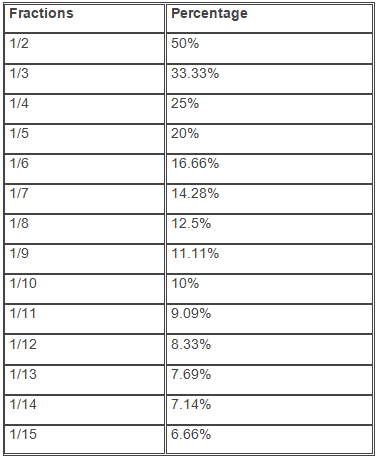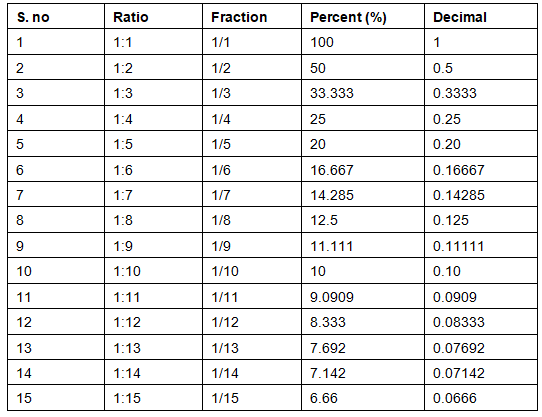Important Formulas: Percentages | Quantitative for GMAT PDF Download
| Table of contents |

|
| Percentage Formula |

|
| Percentage Difference Formula |

|
| Percentage Increase and Decrease |

|
| Converting Fractions to Percentage |

|
| Difference between Percentage and Percent |

|
A percentage is a way of expressing a number as a fraction of 100.
The term "percent" comes from Latin: per centum, meaning "by the hundred." So, when we say 45%, we’re saying 45 out of every 100 parts.

On the GMAT, percentages are commonly used to measure things like growth, reduction, interest rates, proportions, and rates of change.
Examples of Percentages are as following
- 10% = 10/100 = 1/10 fraction
- 25% = 25/100 = 1/4 fraction
- 90% = 90/100 = 9/10 fraction
- Percentages are dimensionless values, meaning they lack any specific units of measurement.
- Therefore, they are referred to as dimensionless numbers. When we state something like "50% of a number," it signifies 50 percent of the entire amount.
- Percentages can also be expressed as decimals or fractions, such as 0.6% or 0.25%. In educational contexts, academic performance is often evaluated using percentages.
- For Example, suppose Ram obtains a score of 78% in his final exam. In that case, this percentage is calculated based on the total marks Ram achieved across all subjects relative to the total available marks.
Percentage Formula
- To determine the percentage, we have to divide the value by the total value and then multiply the resultant by 100.
- Percentage formula = (Value/Total value) × 100
- For Example: 2/5 × 100 = 0.4 × 100 = 40 per cent
How to calculate the percentage of a number?
- To calculate the percentage of a number, we need to use a different formula such as:
P% of Number = X, where X is the required percentage. - If we remove the % sign, then we need to express the above formulas as;
(P/100) x Number = X - Example: Calculate 10% of 80.
Sol: Let 10% of 80 = X
10/100 * 80 = X
X = 8
Percentage Difference Formula
- If we are given with two values and we need to find the percentage difference between these two values, then it can be done using the formula:

- For Example, if 20 and 30 are two different values, then the percentage difference between them will be
% difference between 20 and 30 =
Percentage Increase and Decrease
- The percentage increase is equal to the subtraction of the original number from a new number, divided by the original number and multiplied by 100.
- % increase = [(New number – Original number)/Original number] x 100
where, increase in number = New number – Original number - Similarly, a percentage decrease is equal to the subtraction of a new number from the original number, divided by the original number and multiplied by 100.
- % decrease = [(Original number – New number)/Original number] x 100
Where decrease in number = Original number – New number
So basically if the answer is negative then there is a percentage decrease.
Percentage Chart

Converting Fractions to Percentage
- A fraction can be represented by a/b.
- Multiplying and dividing the fraction by 100, we have

- From the definition of percentage, we have; (1/100) = 1%
Thus, equation (i) can be written as: (a/b) × 100% - Therefore, a fraction can be converted to a percentage simply by multiplying the given fraction by 100.
Example 1: If 16% of 40% of a number is 8, then find the number.
Sol:
Let X be the required number.
Therefore, as per the given question,
(16/100) × (40/100) × X = 8
So, X = (8 × 100 × 100) / (16 × 40)
= 125
Example 2: What percentage of 2/7 is 1/35?
Sol:
Let X% of 2/7 is 1/35.
∴ [(2/7) / 100] × X = 1/35
⇒ X = (1/35) × (7/2) × 100
= 10%
Difference between Percentage and Percent

Example 1: 70% of 30 is 21
Sol: 70 is the percentage.
30 is the base.
21 is the part.
Example 2: 25% of 200 is 50
Sol: 25 is the percent.
200 is the base.
50 is the part.
|
127 videos|154 docs|111 tests
|
FAQs on Important Formulas: Percentages - Quantitative for GMAT
| 1. What is the formula to calculate percentages? |  |
| 2. How do you convert a fraction to a percentage? |  |
| 3. How can I find the percentage increase or decrease? |  |
| 4. What is the difference between a percentage and a fraction? |  |
| 5. How do I calculate the percentage of a number? |  |















